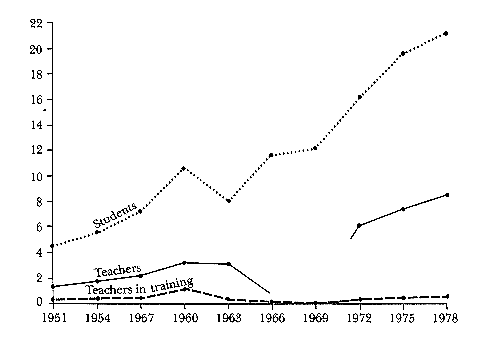The Problem of Standards and Quality
Central to the discussions of teacher policies and educational reforms is the issue of standards for teachers. By the time of the 1978 Third Plenum a teacher shortage greater than that experienced before the Cultural Revolution existed quantitatively and in terms of credentials and competence. As figure 7.1 suggests, the rapid expansion of precollegiate education since the 1950s had not seen a commensurate growth in teacher education or trained teachers. The national shortage in 1977 was estimated at 3.45 million elementary and secondary school teachers (Cui 1979, 31). According to leaders, quality was a bigger problem than quan-

Fig. 7.1.
Elementary and Secondary Expansion, 1951–78
NOTE : Figures for teachers represent the total number of teachers (qualified and unqualified) working in elementary, general secondary, and specialized secondary schools. Where data for elementary teachers were missing (1966–71), no estimates of the total teaching force are used. The numbers of teachers in training refer to students enrolled in either teacher-training schools or colleges. These numbers, as well as those for teachers, are plotted in millions. The numbers of students are represented on this graph in tens of millions.
SOURCE : Department of Planning 1984.
tity. The Chinese indicate that quality—as measured in terms of qualifications (teachers' academic credentials)—fell over the years, as is seen in table 7.1.[7]
If China was to reach its broader educational goals, there had to be a strengthening of standards. Yet given the vigor of the attacks on teacher education and professionalism during the years of the Cultural Revolution, the urgent need to coordinate and regulate the establishment of professional standards for teaching posed a major policy challenge. The study of bureaucratic behavior and the use of authority that were called
[7] The standard formula assumes, for example, that elementary teachers need to be at least graduates of secondary school or a secondary teacher-training school, while junior high school teachers, for example, need at least the equivalent of a zhuanke degree following two to three years of postsecondary training, and senior high school teachers should have completed a four-year college program.
| ||||||||||||||||||||||||||||||||||||
on to meet this policy challenge illustrates three aspects of the process of educational policy formation within the vertical educational policy system: its slow, reactive, and groping character; the power of subordinates; and the limited authority available to education bureaucrats and the resulting strategies they adopt.